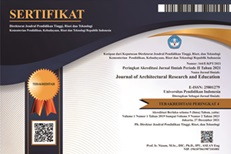STAKEHOLDERS’ PERSPECTIVES ON PROFESSIONAL COMPETENCIES OF ARCHITECTS IN NIGERIA: A CASE FOR CURRICULUM REVIEW
Abstract
This paper examined the broad evidenced-based view of all stakeholders in the architectural profession on the knowledge, skills and attributes expected of architects in Nigeria with a view to identifying the major industry-relevant competencies necessary for the profession. Structured questionnaire was used to elicit information from practising architects, allied building professionals and contractors. Data were analysed using Relative Importance Index and Kruskal-Wallis test. Results revealed that computer-aided design skills and knowledge of sustainable design are the foremost significant new competencies required of architects in Nigeria. The paper concludes that architectural education curriculum needs to be reviewed to include these skills.
Keywords
Full Text:
PDFReferences
Abdulkarim, M. (2005). Between theory, education and practice of architecture. Journal of the Association of Architectural Educators in Nigeria, 4(1), 67 – 71.
Adeyemi, E.A. (2000). Lest we forget. Journal of the Association of Architectural Educators in Nigeria, 1(5), 1- 4.
Alagbe, O.A., Oluwatayo, A.A., Aderonmu, P.A. & Alalade, G.M. (2015). Difference in grading parameters in architectural schools and its impact on the competency rating of future professionals. Frontiers of Architectural Research, 4, 230 – 236.
Amos-Abanyie, S., Botchway, E.A., & Kwofie, T.E. (2014). The relationship between level of architect’s professional competencies and client satisfaction level. Engineering Management Research, 3(2), 10-19.
Architects Accreditation Council of Australia (2015). National Standard of Competency for Architects. Retrieved from https://www.competencystandardsforarchitects.aaca.org.au
Baba, A. (2014). Sustainable curriculum to face the challenges of housing construction in developing countries. International Journal of Science and Research, 3(12), 130 -135.
Chakraborty, M. (2014). Designing Better Architecture Education: Global Realities and Local Reforms. Copol publishing groups. https://books.google.com.ng/books? isbn = 81924733952
Dare-Abel, O.A., Alagbe, O.A., Aderonmu, P.A., Ekhaese, O.N. & Adewale, B.A. (2015). Pathway to architectural education and practice success in Nigeria. Journal of Education and Practice, 6(4), 169-175.
Elendu, T.C. & Abdulkarim, M. (2009). Architecture and Urban Design: Imperatives for curriculum adjustment. Journal of the Association of Architectural Educators in Nigeria, 8(2), 23-26.
Encyclopaedia Britanica (2016). Encyclopaedia Britanica Inc.
Jules, F. A. (1979). Perceptual bases for architectural design. In J.O. Snyder & A.J. Catanese (Eds), Introduction to Architecture (pp 238 -265). New York, US: McGraw-Hill.
Kwofie, T.E., Amos-Abanyie, S. & Botchway, E. (2016). Critical professional competencies of architects in the Ghanaian construction industry. International Journal of Architecture, Engineering and Construction, 5(2), 98-108.
Maina, J.J. (2015). Curriculum evaluation of revised Ahmadu Bello University architecture programme (2012-2015): Feedback from MSc students. Journal of the Nigerian Institute of Architects, 1 & 2, 20 – 28.
National Directorate of Employment (1989). Entrepreneurship Development Programme for Youth Corps Members. Lagos: Federal Republic of Nigeria.
Nicol, D., & Pilling, S. (2000). Architectural education and the profession: Preparing for the future. In D. Nicol & S. Pilling (eds), Changing Architectural Education: Towards a New Professionalism (pp. 1-22). London, UK: Taylor & Francis.
Nikolaev, I.S. (2010). A framework for architectural education. In: The Great Soviet Encyclopaedia (pp. 1970 – 1979), 3 ed. The Gale Group Inc.
Okpoechi, C. (2005). Conflicts in the architect/client relationship: Issues and prospects. Journal of the Association of Architectural Educators in Nigeria, 4(1), 77 – 82.
Oladele, M.A.O. (2008). The sociocultural relevance of architectural education in Nigeria in a global age. Journal of the Association of Architectural Educators in Nigeria, 8(1), 14 – 22.
Oluigbo, S.N. (2005). Improving the quality of architecture graduates from Nigerian universities. Journal of the Association of Architectural Educators in Nigeria, 4(1), 72 – 76.
Onyegiri, I., Okofu, N.P. & Chinedu, A.G. (2014). The value of architectural education in
Nigeria: Students’ expectations in six schools of architecture in Nigeria. Proceedings of 2014 AAE Conference, pp 65 – 69.
Osemeke,M. (2012). Entrepreneurial development and interventionist agencies in Nigeria. International Journal of Business and Social Science, Special Issue, 3(8),255-265.
Polatoglu, C. & Vural, S.M. (2012). As an educational tool the importance of informal studies/studios in architectural design education; case of Walking Instabul 1&2. Procedia- Social and Behavioural Sciences, 47,480-484.
Rapoport, A. (1979). Cultural origins of architecture. In J.O. Snyder & A.J. Catanese (Eds), Introduction to Architecture (pp 22 -29). New York, US: McGraw-Hill.
Royal Institute of the Architects of Ireland (2009). RIAI Standard of Knowledge, Skill and Competence for Practice as an Architect. Retrieved from https://www.riai.ie/.../RIAI_Standard_Knowledge
Salama, A. (1995). New Trends in Architectural Education: Designing the Studios. New York, USA: Oxford University Press.
Salleh, R., Yusoff, M.A., Amat, S.C., Noor, A.M. & Surredah, N. (2013). Profiling industry-relevant competencies of graduate architect through online job advertisement. International Business Research, 6(11),43-51.
Till, J. (2003). Lost judgement. European Association for Architectural Education Prize, 2005, 164-181.
Tunah, S. & Oztekin, K. (2015). Predicaments in the architecture and design education (Turkey as an example). European Scientific Journal, 2, 17 – 27.
Tzonis, A. (2014). A framework for architectural education. Frontiers of Architectural Research, 4, 230 – 236.
UIA (International Union of Architects, 2014). UIA Accord on Recommended International Standards of Professionalism in Architectural Practice. Washington, DC: UIA Professional Practice Commission.
University of Nebraska-Lincoln (2017, Feb 2). The definition of competencies and their applications at NU. Retrieved from www.hr.un.edu/.../corecompetencies.shtml.
Usama, B. (2014). Approaches/strategies for improving architecture education in Palestinian universities. International Journal of Science and Research, 3(4), 670 – 674.
Whitman, P. (2017, Feb 9). The Development and recognition of research in the architectural profession: An Australian update. Retrieved from https://www.eprints.qut.edu.au/.../whitman-hawaii.pdf
DOI: https://doi.org/10.17509/jare.v3i2.38421
Refbacks
- There are currently no refbacks.
Copyright (c) 2021 Journal of Architectural Research and Education

This work is licensed under a Creative Commons Attribution-NonCommercial-ShareAlike 4.0 International License.

This work is licensed under a Creative Commons Attribution-ShareAlike 4.0 International License.








